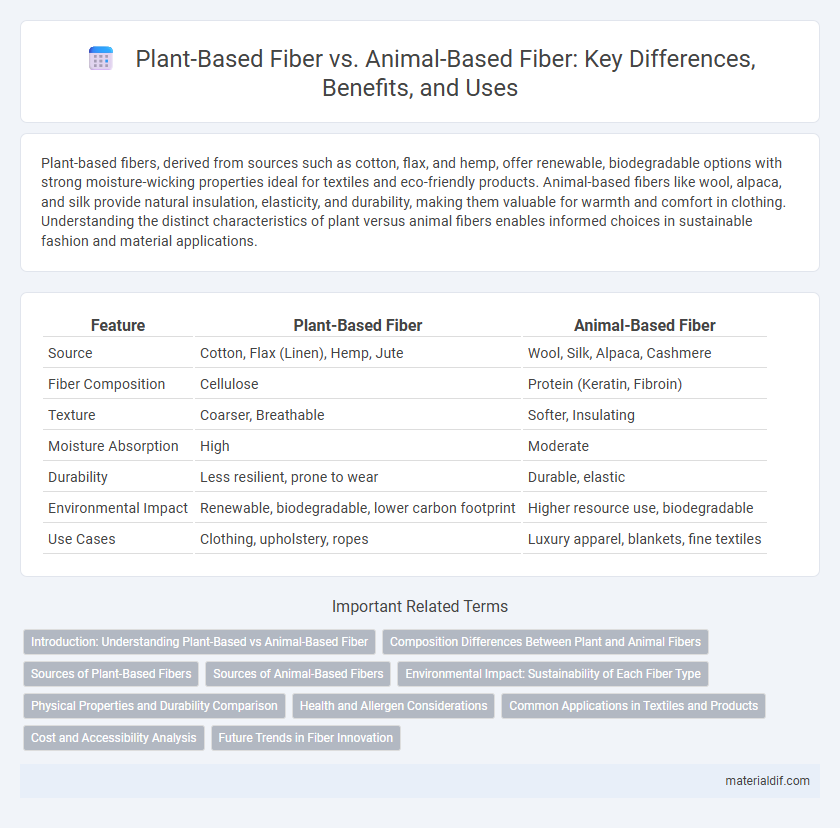Plant-based fibers, derived from sources such as cotton, flax, and hemp, offer renewable, biodegradable options with strong moisture-wicking properties ideal for textiles and eco-friendly products. Animal-based fibers like wool, alpaca, and silk provide natural insulation, elasticity, and durability, making them valuable for warmth and comfort in clothing. Understanding the distinct characteristics of plant versus animal fibers enables informed choices in sustainable fashion and material applications.
Table of Comparison
| Feature | Plant-Based Fiber | Animal-Based Fiber |
|---|---|---|
| Source | Cotton, Flax (Linen), Hemp, Jute | Wool, Silk, Alpaca, Cashmere |
| Fiber Composition | Cellulose | Protein (Keratin, Fibroin) |
| Texture | Coarser, Breathable | Softer, Insulating |
| Moisture Absorption | High | Moderate |
| Durability | Less resilient, prone to wear | Durable, elastic |
| Environmental Impact | Renewable, biodegradable, lower carbon footprint | Higher resource use, biodegradable |
| Use Cases | Clothing, upholstery, ropes | Luxury apparel, blankets, fine textiles |
Introduction: Understanding Plant-Based vs Animal-Based Fiber
Plant-based fibers, derived from sources like cotton, flax, and hemp, consist primarily of cellulose, offering high breathability and moisture-wicking properties ideal for textiles and composites. Animal-based fibers, such as wool, silk, and alpaca, are composed of proteins like keratin and fibroin, providing superior insulation, elasticity, and water resistance. Understanding these fundamental differences in composition and characteristics is essential for selecting the appropriate fiber type in industries ranging from fashion to manufacturing.
Composition Differences Between Plant and Animal Fibers
Plant-based fibers primarily consist of cellulose, a complex carbohydrate that provides rigidity and strength to the fiber structure, while animal-based fibers are mainly composed of protein molecules such as keratin or fibroin, which contribute to their elasticity and warmth. The molecular arrangement in plant fibers includes long chains of glucose units forming crystalline and amorphous regions, enhancing durability and moisture resistance. Animal fibers feature amino acid sequences forming alpha-helices or beta-sheets, which give them unique properties like superior insulation and flexibility compared to their plant-based counterparts.
Sources of Plant-Based Fibers
Plant-based fibers primarily come from cellulose-rich sources such as cotton, flax, hemp, jute, and sisal, known for their sustainable and biodegradable properties. These fibers are derived from various parts of plants including seeds, stems, and leaves, offering versatility in textile and industrial applications. Agricultural residues like straw and bagasse also contribute significantly to plant-based fiber production, promoting eco-friendly alternatives to synthetic materials.
Sources of Animal-Based Fibers
Animal-based fibers originate primarily from mammals such as sheep, goats, alpacas, and rabbits, producing wool, mohair, alpaca fiber, and angora respectively. These fibers are prized for their natural insulation, moisture-wicking properties, and elasticity, making them ideal for high-performance textiles and winter clothing. Unlike plant-based fibers, animal fibers contain keratin, a protein that contributes to their durability and warmth.
Environmental Impact: Sustainability of Each Fiber Type
Plant-based fibers, such as cotton, hemp, and flax, offer greater sustainability due to their renewable nature and lower carbon footprint compared to animal-based fibers like wool or silk. The cultivation of plant fibers typically requires less water and energy, and promotes soil health through crop rotation, reducing environmental degradation. Animal-based fibers often involve higher greenhouse gas emissions and land use, impacting biodiversity and contributing to deforestation.
Physical Properties and Durability Comparison
Plant-based fibers such as cotton, flax, and hemp typically exhibit high tensile strength and better moisture absorption, making them breathable yet prone to degradation under prolonged exposure to sunlight and moisture. Animal-based fibers like wool, silk, and alpaca have superior elasticity, insulation properties, and natural resilience to wear, offering enhanced durability against stretching and abrasion. The physical structure of animal fibers, including scale-like cuticles and crimp, contributes to their ability to maintain shape and resist damage compared to the smoother, cellulose-based plant fibers which are more susceptible to environmental stress.
Health and Allergen Considerations
Plant-based fibers, such as cotton, flax, and hemp, are hypoallergenic and breathable, making them ideal for sensitive skin and reducing the risk of allergic reactions. Animal-based fibers like wool and alpaca contain lanolin and keratin proteins, which can trigger allergies or skin irritation in susceptible individuals. Choosing plant-based fibers supports better skin health due to their moisture-wicking properties and lower allergen potential compared to animal-derived textiles.
Common Applications in Textiles and Products
Plant-based fibers such as cotton, linen, and hemp are commonly used in breathable, lightweight textiles ideal for apparel, home furnishings, and eco-friendly packaging. Animal-based fibers like wool, silk, and alpaca provide warmth, elasticity, and luxury, making them preferred choices for high-end clothing, upholstery, and specialty textiles. The distinct properties of plant versus animal fibers determine their application in products ranging from durable outdoor fabrics to soft, insulating winter wear.
Cost and Accessibility Analysis
Plant-based fibers such as cotton, hemp, and flax generally offer lower production costs and greater accessibility due to widespread cultivation and renewable sourcing compared to animal-based fibers like wool, silk, and alpaca, which require specialized animal care and longer processing times. The scalability of plant-based fibers benefits textile manufacturers with reduced raw material expenses and consistent supply chains, while animal-based fibers often incur higher costs linked to animal husbandry, seasonal availability, and labor-intensive harvesting. Market availability and price fluctuations favor plant fibers in mass-market applications, whereas animal fibers retain niche demand in luxury and performance textiles, impacting overall cost-efficiency and accessibility.
Future Trends in Fiber Innovation
Future trends in fiber innovation emphasize sustainable, plant-based fibers like hemp, bamboo, and Tencel, which offer eco-friendly alternatives to traditional animal-based fibers such as wool and silk. Advances in biotechnology and material science are enhancing the durability, softness, and moisture-wicking properties of plant fibers, making them more competitive in textile applications. Growing consumer demand for cruelty-free, biodegradable materials is accelerating investments in the development of hybrid fibers and bioengineered alternatives that combine the strengths of both plant and animal sources.
Plant-Based Fiber vs Animal-Based Fiber Infographic

 materialdif.com
materialdif.com